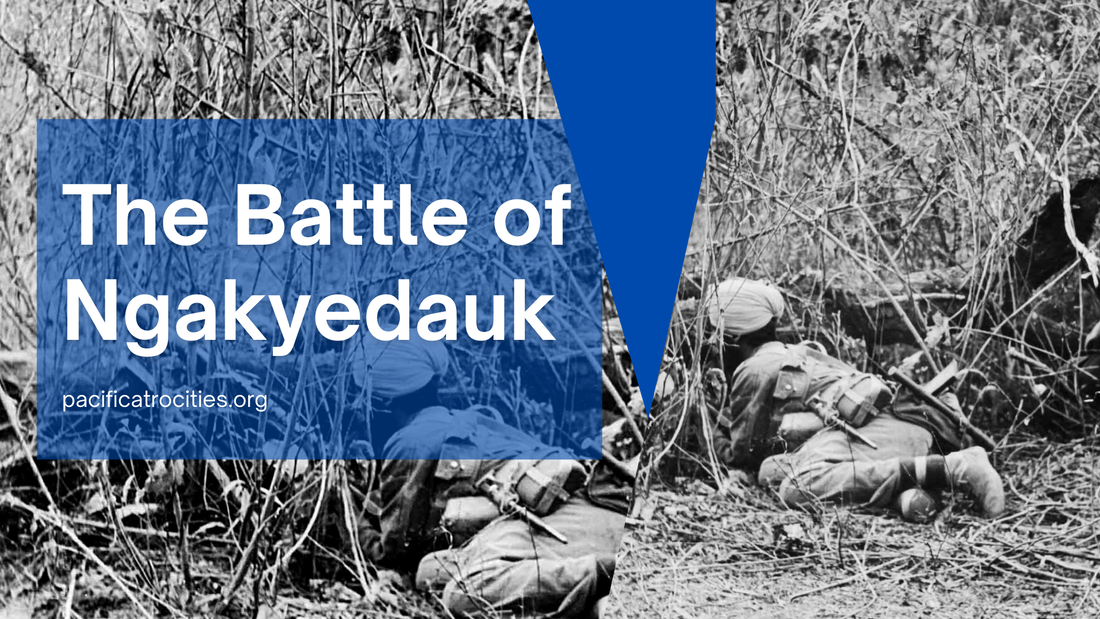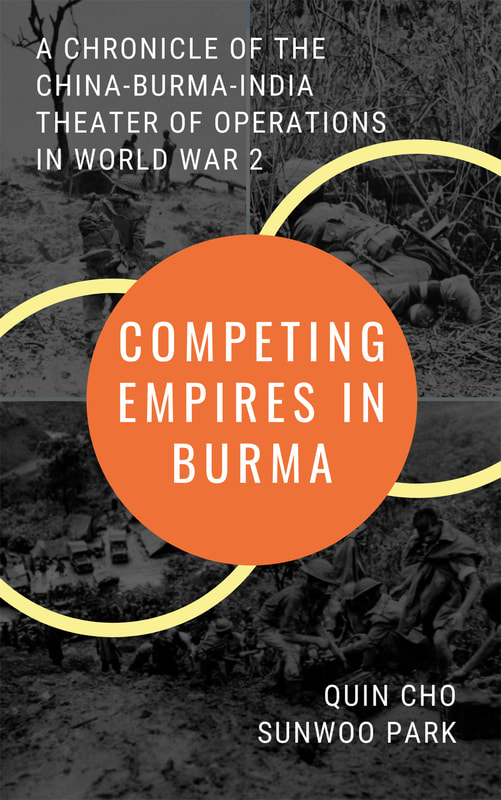|
by Janki Patel The Battle of Ngakyedauk is also known as the Battle of Sinzweya, more commonly referred to as the defense of the Admin Box. This battle took place at the southern front of Burma in February 1944 in the Southeast Asian Theatre of World War II. The Allies, which consisted of British, Indian, and Chinese troops, were driven away by the Imperial Japanese Army. However, the Allied forces were not appropriately trained initially, which allowed the Japanese Army Air Force to raid Calcutta and many other Indian cities. As a result, the raids, the Imperial Japanese Army recaptured Burma. The Allies had planned to regain control of Burma. To do so, they underwent jungle training extensively, as the Japanese consistently ambushed them by rivers and jungle-covered hills. The British, in 1943, made several attempts to regain control of Burma, but the heavy rains prevented them from doing so. The Imperial Japanese Army at the time was building their confidence as they had been launching many counterattacks. They believed that by launching Operation Z or HAGO during the first week of February, they would then force the Allies to send for back-up to the city of Arakan from the central front. It was ultimately clearing the way for the Japanese offensive to come in. The Japanese Batallion (I/213 Regiment, also known as the Kubo Force) began crossing the Mayu range to plan for an ambush by the coastal road where the 5th Indian Division was supplied. Another obvious target for the Japanese was the administrative area in Sinzweya, defended by headquarters and lines of communication units, with 25 light AA / anti-tank regiments, RA. The defenders were later joined by part of the 4th Battalion 8th Gurkha Rifles and artillery 8 HAA Regiment Royal Artillery and 6 Medium Regiment RA. Ammunition dumps accumulated at the foot of the western wall of a 150-foot-high central hill called "Ammunition Hill." When Major General Messervy arrived at the Admin Box, he was followed by several of his commanders, who reached small parties through Japanese forces, leaving the defense of the box to Evans. At the same time, he concentrated on re-establishing control and command of the rest of the division. Meanwhile, an Allied Dakota airliner dropped batches and ammunition on cut-off units, including defenders of the Admin Box. The Japanese did not anticipate this development. The first air missions met with resistance from Japanese fighters, and some airliners were forced to return. Still, three Spitfire squadrons, operating from new airports around Chittagong, gained air superiority over the battlefield. Sixty-five Japanese aircraft were lost or damaged due to the loss of three Spitfires. Regardless of the actual numbers, Japanese fighters were quickly expelled from the area. On the night of February 7, some Japanese soldiers captured the division's main changing station. This could increase the defenders' determination, who now realized what fate would befall them if they gave up. Japanese fire caused heavy losses in the crowded defenses and set fire to ammunition dumps twice. All attempts to attack the defenders were thwarted by tanks on which the Japanese had no counter once their few mountain cannons were out of ammunition. The Japanese attempted a total attack on February 14 and managed to capture one hill on the perimeter. Until February 22, the Japanese starved for several days. Colonel Tanahashi, commanding the Japanese 112th Infantry Regiment, which provided the main part of Sakurai's force, said his regiment had been reduced from the original 2150 force to 400 men and refused to carry out further attacks. On February 24, he cut off radio communications and withdrew without permission. Sakurai was forced to suspend the operation on February 26. In the second week of March, the 161st Indian Infantry Brigade finally seized the "Tortoise" and the other fortifications around Razabil by flanking maneuver before the division was withdrawn into reserve. The 26th Indian Division and the 36th British Division resumed the offensive in late March and early April. The 36th Division captured the rail tunnels on April 4. On April 6, the troops of the 26th Division seized a vital hill named Point 551, which dominated the region and where the Japanese had won a major victory just under a year earlier. The Japanese had moved the 54th Division to Arakan. They concentrated a force of four battalions under Colonel Koba of the 111th Infantry Regiment against the 81st West African Division in the Kaladan Valley. With the support of an Indian National Army unit and local Arakanese, this force staged a successful counterattack against the isolated West African division, forcing it to retreat and ultimately withdraw from the valley. Akyab remained in Japanese hands until January 1945. A new Allied advance combined with amphibious landings drove the Japanese back from Arakan, inflicting heavy losses on the landing troops to cut off their retreat along the coast. To read more:Sources
"Battle of the Admin Box – 1944 – World War II." YouTube, History Media-HD, January 11, 2021, www.youtube.com/watch?v=zPY8RoCm02k. "Battle of the Admin Box." Wikipedia, Wikimedia Foundation, June 3, 2021, en.wikipedia.org/wiki/Battle_of_the_Admin_Box. Gnam, Carl, et al. "Defending the 'Admin Box' IN BURMA'S Arakan Region." Warfare History Network, May 29, 2020, warfarehistorynetwork.com/2015/08/27/defending-the-admin-box-in-burmas-arakan-regi on/. Latimer, Jon. "Battle of the Admin Box. (Cover Story)." World War II, vol. 19, no. 8, Dec. 2004, pp. 48–53. EBSCOhost, search.ebscohost.com/login.aspx?direct=true&AuthType=ip,sso&db=mth&AN=1487349 9&scope=site.
0 Comments
Leave a Reply. |
- Home
- Stories
-
Internship
- Summer 2024 Internship
- Summer 2023 Internship
- Fall 2022 Internship
- Summer 2022 Internship
- Summer 2021 Internship
- Fall 2020- Spring 2021 Internship
- Summer 2020 Internship
- Fall 2019 Internship
- Summer 2019 Internship >
- School Year 2018-2019 Internship
- Summer 2018 Internship >
- Fall 2017 Internship
- Summer 2017 Internship >
- Books
- Archives
-
Resource Page
-
Supplementary Research Guides
>
- Unit 731 - Guide >
-
Philippines' Resistance - Guide
>
- Philippines World War II Timeline
- The Japanese Invasion & Conquest of the Philippines
- Bataan Death March
- Formation of Underground Philippines Resistance
- Supplies of the Guerrilla Fighters
- The Hukbalahap
- Hunter's ROTC
- Marking's Guerrillas
- United States Army Forces in the Philippines of Northern Luzon (USAFIP-NL)
- The Aetas
- Chinese and Filipino-Chinese Nationalist Guerrilla Units
- The Female Faces of the Philippine Guerrillas
- Rising Sun Flag - Guide >
- Pinay Guerrilleras - Guide >
- Fall of Singapore - Guide >
- Three Years and Eight Months - Guide >
- Siamese Sovereignty - Guide >
- The Khabarovsk War Crimes Trial - Guide >
- Unit 731 Cover-up : The Operation Paperclip of the East - Guide >
- Marutas of Unit 731 - Guide >
- Prince Konoe Memoir - Guide >
- Competing Empires in Burma - Guide >
- Battle of Shanghai - Guide >
- Ishi Shiro - Guide >
- Taiwan The Israel of the East - Guide >
- Seeking Justice for Biological Warfare Victims of Unit 731 - Guide >
- Rice and Revolution - Guide >
- Clash of Empires - Guide >
-
Hunger for Power and Self-SufficiencyI - Guide
>
- The Influence of War Rations on Post-War Culinary Transformations
- How World War II Complicated Food Scarcity and Invention
- American Military Innovations
- Government-Sponsored Food Inventions in Europe during World War II
- Feeding the Army: The Adaptation of Japanese Military Cuisine and Its Impact on the Philippines
- Mixed Dishes: Culinary Innovations Driven by Necessity and Food Scarcity
-
Denial A Quick Look of History of Comfort Women and Present Days’ Complication - Guide
>
- The Comfort Women System and the Fight for Recognition
- The Role of Activism and International Pressure
- The Controversy over Japanese History Textbooks
- The Sonyŏsang Statue and the Symbolism of Public Memorials
- Activism and Support from Japanese Citizens
- The Future of Comfort Women Memorials and Education
- Echoes of Empire: The Power of Japanese Propaganda - Guide >
- Lesson Plans >
-
Supplementary Research Guides
>
|
Pacific Atrocities Education
730 Commercial Street San Francisco, CA 94108 415-988-9889 |
Copyright © 2021 Pacific Atrocities Education.
We are a registered 501 (c)(3) charity. |
- Home
- Stories
-
Internship
- Summer 2024 Internship
- Summer 2023 Internship
- Fall 2022 Internship
- Summer 2022 Internship
- Summer 2021 Internship
- Fall 2020- Spring 2021 Internship
- Summer 2020 Internship
- Fall 2019 Internship
- Summer 2019 Internship >
- School Year 2018-2019 Internship
- Summer 2018 Internship >
- Fall 2017 Internship
- Summer 2017 Internship >
- Books
- Archives
-
Resource Page
-
Supplementary Research Guides
>
- Unit 731 - Guide >
-
Philippines' Resistance - Guide
>
- Philippines World War II Timeline
- The Japanese Invasion & Conquest of the Philippines
- Bataan Death March
- Formation of Underground Philippines Resistance
- Supplies of the Guerrilla Fighters
- The Hukbalahap
- Hunter's ROTC
- Marking's Guerrillas
- United States Army Forces in the Philippines of Northern Luzon (USAFIP-NL)
- The Aetas
- Chinese and Filipino-Chinese Nationalist Guerrilla Units
- The Female Faces of the Philippine Guerrillas
- Rising Sun Flag - Guide >
- Pinay Guerrilleras - Guide >
- Fall of Singapore - Guide >
- Three Years and Eight Months - Guide >
- Siamese Sovereignty - Guide >
- The Khabarovsk War Crimes Trial - Guide >
- Unit 731 Cover-up : The Operation Paperclip of the East - Guide >
- Marutas of Unit 731 - Guide >
- Prince Konoe Memoir - Guide >
- Competing Empires in Burma - Guide >
- Battle of Shanghai - Guide >
- Ishi Shiro - Guide >
- Taiwan The Israel of the East - Guide >
- Seeking Justice for Biological Warfare Victims of Unit 731 - Guide >
- Rice and Revolution - Guide >
- Clash of Empires - Guide >
-
Hunger for Power and Self-SufficiencyI - Guide
>
- The Influence of War Rations on Post-War Culinary Transformations
- How World War II Complicated Food Scarcity and Invention
- American Military Innovations
- Government-Sponsored Food Inventions in Europe during World War II
- Feeding the Army: The Adaptation of Japanese Military Cuisine and Its Impact on the Philippines
- Mixed Dishes: Culinary Innovations Driven by Necessity and Food Scarcity
-
Denial A Quick Look of History of Comfort Women and Present Days’ Complication - Guide
>
- The Comfort Women System and the Fight for Recognition
- The Role of Activism and International Pressure
- The Controversy over Japanese History Textbooks
- The Sonyŏsang Statue and the Symbolism of Public Memorials
- Activism and Support from Japanese Citizens
- The Future of Comfort Women Memorials and Education
- Echoes of Empire: The Power of Japanese Propaganda - Guide >
- Lesson Plans >
-
Supplementary Research Guides
>

